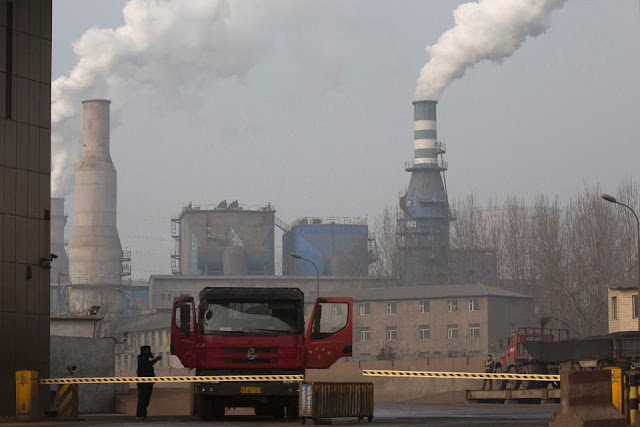Regardless of where you stand on the issue of climate change and CO2,
this is an interesting and informative read.
Over the past decade, the U.S. has decreased annual carbon dioxide emissions
by nearly 800 million tons.
In this Dec. 30, 2016 photo, a truck leaves with metal products from the sprawling complex that is a part of the Jiujiang steel and rolling mills in Qianan in northern China's Hebei province. Faced with choking smog in the Chinese capital, Chinese media and policy circles often point to a list of culprits: the central government's inability to shut down polluting steel mills, the middle class's insatiable demand for cars, poorer segments of society's insistence on burning coal. (AP Photo/Ng Han Guan)
In a previous article, I discussed the relentless upward march of global carbon dioxide emissions. According to data from the 2018 BP Statistical Review of World Energy, the world reached a new all-time high for global carbon dioxide emissions in 2017.
Today, I want to discuss trends and relative contributions from the world's most significant carbon dioxide emitters.
Since 1965, no country has put more carbon dioxide into the atmosphere than the United States. The 264 billion metric tons of carbon dioxide the U.S. has emitted to the atmosphere represented 22.5% of global emissions during that time, and was well ahead of the cumulative 216 billion metric tons from the European Union (EU). In second place among countries was the 188 billion metric tons emitted by China.
But as China has industrialized -- with a heavy reliance on coal-fired power -- Chinese emissions have rocketed past both those of the U.S. and the EU:
Carbon dioxide emissions from 1965 to 2017. ROBERT RAPIER
China's emissions passed those of the U.S. in 2005, and by 2012 had surpassed the combined contribution of both the U.S. and the EU. Should recent trends continue, China will be responsible for the most atmospheric carbon dioxide in less than 20 years.
China has lots of regional company, too. The Asia Pacific region is home to both China and India -- the world's two most populous countries and two of the largest carbon dioxide emitters. It is also home to other fast-growing and/or populous countries, like Indonesia, Pakistan, Bangladesh, Vietnam, and Japan. Over the past decade, this region's carbon dioxide emissions have grown at an average annual rate of 3.1%, which was nearly triple the global average. As a result, Asia Pacific is now responsible for nearly 50% of global carbon dioxide emissions.
Thus, Asia Pacific as a whole continues to drive global carbon dioxide emissions higher:
Asia Pacific carbon dioxide emissions continue to climb. ROBERT RAPIER
There are some positives in the data. Over the past decade, the U.S. has decreased annual carbon dioxide emissions by nearly 800 million tons. This is by far the most of any country in the world, and is primarily a result of shifting coal-fired power to natural gas and renewables. The EU has also made significant strides, reducing its annual carbon dioxide emissions by 681 million tons.
These reductions paled in comparison to China's two billion ton per year increase in emissions, but China's emissions have been relatively flat since 2013. This, combined with the decreases in the U.S. and EU, have helped slow the growth rate of carbon dioxide emissions in the past decade versus the previous decade:
Global carbon dioxide emissions. ROBERT RAPIER
It is true that the U.S. has put more carbon dioxide into the atmosphere than any other country, and that U.S. per capita emissions are among the highest in the world. But it is also true that the U.S. won't solve this problem alone (even if we weren't dropping out of global climate treaties).
Regardless of the actions taken by developed countries, the primary driver of carbon dioxide emissions in coming decades will be areas of the world with huge populations, but with low, and growing per capita emissions. A small increase in those per capita emissions can result in a huge increase in overall emissions -- amply demonstrated by Asia Pacific's skyrocketing emissions.
Thus, the most pressing need in the world today is to ensure that countries can develop without a heavy reliance on coal and other fossil fuels, because this is the reason for the status quo.
"The most pressing need in the world today", is typical climate change hysteria. I can think of plenty of needs that are far more pressing. Check out my blog on child sex abuse - the worst atrocity mankind has ever inflicted upon itself. Climate change doesn't come close and is no more than a distraction from the real evil going on in the world today.
Robert Rapier has over 25 years of experience in the energy industry as an engineer and an investor. Follow him on Twitter @rrapier or at Investing Daily.




No comments:
Post a Comment